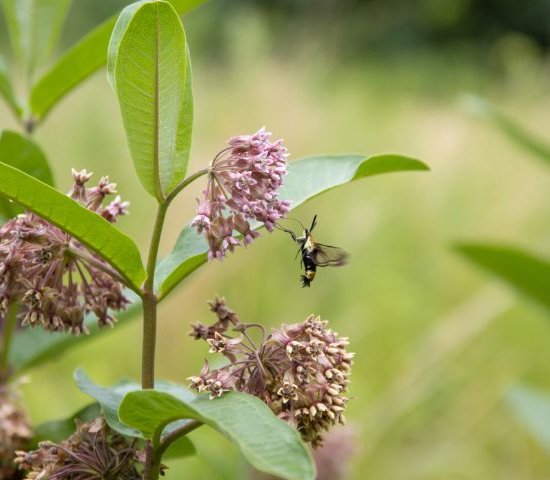
The National Environmental Education Foundation (NEEF) is pleased to announce the awardees for the 2024 Biodiversity Conservation Grant: Enhancing Pollinator Habitats on America’s Public Lands. Thanks to major support from Toyota Motor North America, this grant will provide $200,000 in funding toward the creation, restoration, and protection of habitat for important pollinator species such as butterflies, bees, bats, and more.
According to the US Department of Agriculture, three-fourths of the world’s flowering plants—including 35 percent of food crops—require pollinators to grow and reproduce. Pollinators are essential to the health of our ecosystems, sustaining much of the world’s flora and contributing to cleaner air and water, improved habitat for wildlife, and reduction in harmful soil erosion. They are also major contributors to the global economy—one out of every three bites of food we eat exists thanks to pollinators.
“Now in our fourth year of sponsoring the Biodiversity Conservation Grant, we have been impressed with the success of the grantee projects so far,” said Becky Martin, manager of Environmental Sustainability at Toyota. “We believe this year’s projects will help Toyota meet our goal to enhance 26,000 acres of pollinator habitat in North America by 2025.”
The grant-funded pollinator projects will be completed in the summer of 2025. In addition to supporting new and existing pollinator habitat projects, funds will also be used to incorporate engagement activities and intentional community outreach with historically marginalized communities and underrepresented audiences in the outdoors. These engagement activities are designed to educate the public and empower them to create and protect local pollinator habitats.
“Simply put, without pollinators, our country’s public lands would not survive,” said Sara Espinoza, president and CEO of NEEF. “We are proud to work with a partner like Toyota that understands the importance of increasing biodiversity to support native pollinators, and the Biodiversity Conservation Grant goes a long way toward achieving this.”
List of Grantees Awarded
Returning the Regal Fritillary Butterfly to New York (Fund for the City of New York, New York, NY)
This project aims to enhance the grasslands of Freshkills Park in Staten Island, New York City, over one year, with the goal of reintroducing the regal fritillary butterfly, which has seen its habitat decline significantly and requires focused conservation efforts to ensure its survival. Freshkills Park is recognized as potentially the only suitable area in New York for regal fritillaries, offering a blend of protected grasslands and accessible public viewing locations.
Program staff will modify the existing 1000-acre habitat to support the re-introduction of regal fritillaries by planting preferred host plants like native violets and nectaring plants like eastern milkweed. The community will be engaged through a new K-12 and college-level curriculum on regal fritillary butterflies coupled with extensive volunteer involvement in planting and invasive species removal.
Volunteers will lead planting and invasive species removal efforts, potentially earning coursework credits in biodiversity monitoring. The project aims to foster stewardship of natural areas and raise awareness about the vital role of pollinators in human society and biodiversity conservation, particularly in a community park that was once the world's largest landfill.
From the River to the Ridges: Improving Pollinator Habitat Along the Salmon River (Salmon Valley Stewardship, Salmon, ID)
The goal of this project is to engage the community in critical monarch habitat expansion along 20 miles of the Salmon River corridor. The project site falls within the Salmon River Breaks Project Area, an 11,000-acre tract that has been treated with prescribed burns, mechanical thinning, and noxious weed removal for the last 13 years.
Salmon Valley Stewardship (SVS) volunteers will make and plant seedballs, which are essential to reseeding the rocky, steep terrain and shallow soils of the river valley, in addition to hand-pulling invasive plants and planting milkweed and other native pollinator-friendly plants along the 20-mile corridor. This work will directly improve 1,625 acres of pollinator habitat—about twice the area of Central Park in New York City.
In addition, the project provides a unique service-learning opportunity with the Salmon High School natural resources class, who will travel to the project sites and spend time with SVS staff learning about plant and pollinator identification and helping with habitat restoration through seedball application. Funding will also support four college internship positions and reach approximately 150 individuals through education and outreach opportunities.
Kentucky Nature Preserve Pollinator Project (Office of Kentucky Nature Preserves, Frankfort, KY)
This project seeks to improve biodiversity and protect native pollinator species in Kentucky's Bluegrass Region through strategic invasive species management and habitat restoration efforts at Blue Licks State Nature Preserve, Short's Goldenrod State Nature Preserve, and Kentucky River Palisades/Tom Dorman State Nature Preserves.
The Office of Kentucky Nature Preserves (OKNP) will use prescribed burns, mechanical removal, and chemical treatment to target invasive species across approximately 560 acres, creating or restoring habitat patches with diverse native plants crucial for pollinator food and shelter. These efforts are complemented by educational and outreach initiatives, including workshops at institutions like the University of Kentucky, aimed at engaging hundreds of participants in native flora and fauna education, invasive species eradication, and pollinator propagation.
Volunteer training sessions at state parks, including four hands-on workshops, will equip approximately 100 volunteers and Preserve staff with essential skills for habitat restoration and invasive species management. These activities aim to empower community members, park staff, and conservation professionals to sustainably manage pollinator habitats, contributing to the long-term conservation of biodiversity in the region.